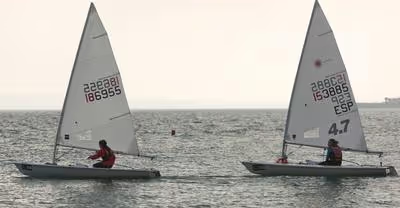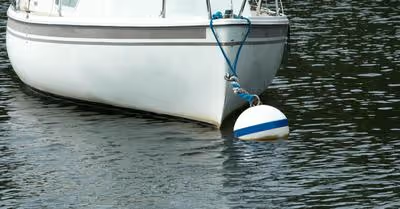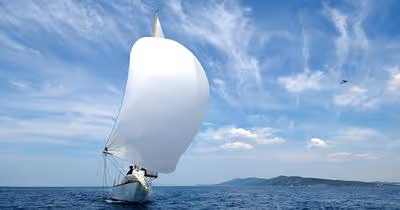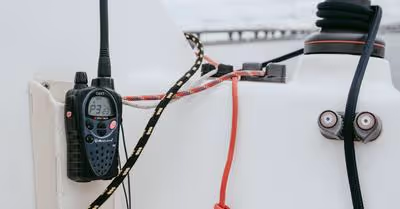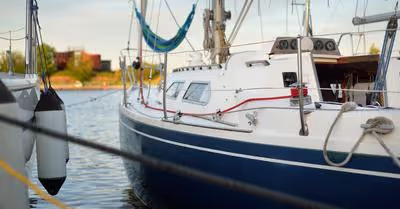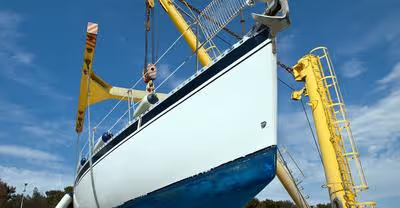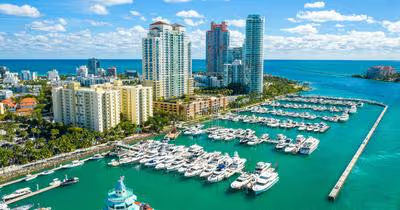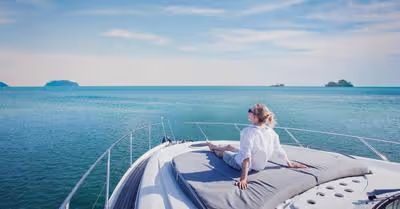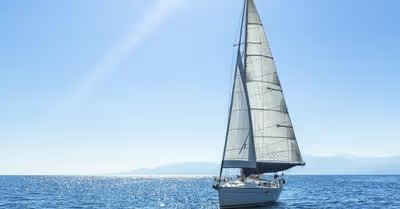Table of Contents
Classifications of Sailboats
To begin classifying each sailboat type, the best thing to do is to see what type of hull it has. Since that is the first thing about a boat upon building one, the hull is an easy way to group a selection of boats together.
In addition, the rigging and keel type also separates different boat types. Even though you cannot see the keel, it still adds important characteristics to the boat's style and performance.
Monohulls
Monohulls are the most common hull type on the sailboat market. These boats provide a decent amount of storage and solid stability.
These conventional sailboats are some of the easiest to navigate since their design is meant for casual sailing. The longer beam slightly improves onboard functions, which is great for first-time sailors or people that want an enjoyable ride.
These boats offer some of the best speed and cruising capabilities. If in rough conditions, they are subject to being rocked a bit more than multi-hulled boats.
Catamarans (two hulls)
These boats have two hulls that are combined together by a cross member, or like a backbone for the boat. This provides an increased level of stability that you can definitely notice from the monohull boats.
If these boats are designed properly, they can have higher speeds and are more responsive in rougher waters. However, any slight misstep in the hull’s design can negatively impact these boats.
While they handle much better than monohulls, catamarans do not have the best stability. When looking at overall speed and performance, they do navigate the waters much easier than multi-hulled boats.
Trimarans (multi-hull)
These vessels are between three and five hulls, but three is the most common. When it comes to four or five hulls, these are not typically for recreational use.
Trimarans have three hulls and are extremely stable in comparison to the other hull variations. With their lower center of gravity, these boats are great for cruising.
If you are looking for the best stability to handle tough conditions, then a multi-hull is the way to go. This offers the best opportunity to stay floating the correct way in the event of rough water or storms.
Type of Keel
Just about all boats have some type of keel unless they are flat-bottom boats. Some keels take up the entire length of the boat, while others look like a tiny wing underneath.
The keel helps with navigating through the water to support maneuverability, comfort, and speed. The different types of keels you will see are:
- Full keel
- Bulb
- Wing
- Bilge
- Fin
- Lifting
Each one carries a unique purpose to the boat. As such, most boats have some type of keel to either help with balance or for more speed.
Sail Plan
Last but not least is the sail plan. This is the types of sails used, how many are used, and how the sails are mounted to masts, often referred to as rigging.
Each boat can have different types of sail plans but still have similar vessel designs. Depending on the brand, you can have almost identical boats, but the sail plan can greatly change the price and performance of a boat.
Most Common Sailboat Types
Depending on what the boat is being used for, such as racing, cruising, or deep bluewater, you can easily tell the difference between a handful of boats. The ones that are similar in length and sail types are going to be hard to differentiate.
Dinghy
One of the most fun-sounding boats on the market is a dinghy. These boats are the smallest sailboats you can find and serve a variety of purposes.
For newbies wanting to get a test on the wind and water, sailing with a dinghy will give you everything you desire. These boats have an open hull, a mast, and one sail.
These are sometimes used on larger vessels as a way to safely check out shallow waters since they range between six and 20 feet. In addition, this is one of the simpler options since there is not any special equipment to control.
Keep in mind that you would be exposed to just about any element or rough water was thrown at you. These boats are not suitable for any offshore navigation.
Catboats
Cats, not to be confused with catamarans, are simple boats with an easy sail plan. They typically have one sail and mast and are quite small, which makes them pretty easy to control.
If you have a dinghy that is used for racing or sailing in general, you likely have a catboat. There is no standing rigging, so these boats are easy to spot.
You would not want to use these boats in any form of offshore sailing or rougher waters. For someone wanting to get used to the water, these are great.
Sloops
If you closed your eyes and imagined a type of sailboat, you are likely going to picture a sloop. These boats are the most common type on the water today.
These boats have one mast and a triangle mainsail, which is sometimes referred to as a Bermuda sail. They range widely in size, from about 12 feet all the way to 50 feet.
If you are a movie fan and love the Pirates of the Caribbean films, then you have noticed these boats. Sloops were often used by pirates in the 16th and 17th centuries and were built in the Caribbean.
There are many different types of sloops, which all will have different types of sails. For example, here is a fractional sloop that looks very similar to regular sloops.
You can think of sloops as an all-around sailing boat to get the job done. They might not be the fastest but can handle just about any situation at a comfortable speed.
Cutter
Cutters are a lot like sloops when you first take a look at them. They are Bermuda rigged, but most commonly have two or more headsails.
They typically just have one mast, but sometimes have an additional one with a mainsail. They offer more sail area to go faster but there is more wear on the mast and rigging.
Cutters are just as popular for cruising as sloops are, which means you will see plenty of them. In addition, they typically are about the same length as a sloop.
These typically have a lower center of gravity and can provide a much better handle in rougher waters. While they are much harder to capsize, they are a little more advanced when trying to use the rigging.
You might need several hands to work this type of boat successfully in rougher waters. With that being said, it is still a great boat to use offshore or racing.
Yawl
While this boat sounds like a country slang term, yawl sailboats are one of the more difficult boats to navigate. The term yawl refers to the sail plan that uses a main mast in the front and a much smaller one in the back.
The aft mast is referred to as a mizzenmast and is a lot more difficult to sail than sloop boats. While these boats were common back in the day, you might see some vintage ones on calmer waters like daysailers.
Ketch
In comparison to a cutter or sloop, there are not a lot of differences between them and a ketch. The main difference is the additional mast behind the mainsail.
They are also similar to yawls, but the mizzen does not hang off the stern of the boat. These boats are powerful and great for offshore sailing.
With increased stability and shorter masts, you will not likely find these boats winning a race compared to the others mentioned. But in rough waters, these boats have some of the best durability.
Since it offers great offshore handling and is fairly mild in comparison to other boats, they make for great offshore boats. You likely will not see as many of these today but plenty is still on the market.
Schooner
Schooners used to be the most popular sailing boat before sloops entered the market. These boats are fairly simple to sail but much slower compared to sloops.
They have two masts, with a smaller one upfront and a taller one in the back. These are sometimes called gaff-rigged sailboats, which is just another way to classify the sails.
Gaff-rigged schooners have a rectangular sail attached to a pole known as the gaff. Schooners in general are fast and powerful for sailing but can be complex at times.
Just like cutters, these boats can be difficult to handle at times due to the adjustments needed on the rigging. You are definitely going to use some manual labor if you need to make any adjustments.
Other Types of Sailboats
You will likely see plenty of other sailboats on your travels at sea. However, some are more common than others depending on your location.
While everyone has a different purpose for sailing, each boat is also going to help carry out that specific purpose. In addition, some of these boats are gaining in popularity.
Hydrofoil (racing)
One of the weirder sounding sailboat names is the hydrofoil. These boats are a unique class of their own and are specifically used in races such as America’s Cup.
These boats have thin-winged foils underneath the boat that help them lift out of the water. This, in turn, improved speed, and reduced displacement to essentially nothing at all.
These boats are so unique that you can clearly tell what one is once you see them jumping out of the water. These vary in length but are typically under 50 feet.
Clipper
Before steam-powered vessels hit the market, the clipper was one of the last sailboat designs out there. These boats had a large cargo area to transport goods.
Since they were in competition with steam-powered sailboats, they had to design these to be fast to keep up. While many of these are not typically seen in the waters today, you can spot them in coastal waters in other countries.
Gaff-rigged
Gaffers are very similar to other boats listed above, but of course, stand out in small ways. The mainsail is held up by the spar, or gaff. This is hauled up by a separate halyard.
You will likely see these boats rigged up with some type of topsail. This greatly adds some power if the wind is able to hit it just right.
This type is not the most desirable for today’s sailboats due to the added weight and material costs. Older boats will likely still have this design.
Beach Catamaran
A beach catamaran is a pleasure sailboat that is used strictly for day sailing. These are roughly 14 to 20 feet long and have low drafts to enter shallow waters.
Surprisingly, they are fast and have the agility to sail with other popular sailboats. As long as they are in calmer waters, these are great boats just to get out on the water.
Cruising Catamaran
While the beach catamaran is typically the one to hang around shallow waters, the cruising catamaran takes it a step further. These boats are very similar to the beach ones but can hold more people to accommodate larger parties.
These are usually mono-hull that are meant to cruise. Along with their low drafts for shallow waters, these boats range between 25 and 50 feet long.
Cruisers
While many sailors might refer to their boat as a “cruiser” on the water, these specific boats are built for one purpose. These boats have a few different uses depending on the brand.
Some cruisers vary in length from 16 to over 50 feet long. You might even see these being raced in events since they are built to glide on water.
Small Boat Daysailer
Daysailer boats are very similar to dinghies to the point that you might as well call it a dinghy. However, they are typically between 14 and 20 feet, so they are usually a bigger dinghy.
They are intended to be used for casual day sailing and can accommodate around four people. These are great boats for people wanting to get on the water for an enjoyable ride.
Sailboats with Motors
Motor Sailers are exactly like they sound, as they are sailboats that utilize motors to move in the water. These motors help the boat move when under power or sail.
You might see a little more luxury in these boats and they are over 35 feet long. Since they use a lot more power in the motor, they are slower and heavier. They also have larger fuel and grey tanks to allow long days at sea.
Racers and Cruisers
When thinking of hybrid sailboats, the racer-cruiser comes to mind. These boats are built to enjoy a night on your boat but to also go fast.
They are not really designed to do competitive racing, but you can still enjoy the open water at great speeds. Since these are generally 25 feet and over, you can expect a comfortable ride without having to compromise with performance.
As for racing sailboats, these can fit a variety of different categories. Some racing sailboats usually have nothing special on board, just bare essentials to get the boat moving.
The faster these boats are, the better, as they are not built to be a comfortable ride. The sizes of these range between 20 and 70 feet, which means there are plenty of options.
Brig
While these boats are not commonly used today, brig boats were a turning point in American history. These were used in the American revolution and carried between 10 and 18 guns.
With two masts and a square-rigged foremast, they were also built tough. Many larger sailboats you see today have characteristics of brig sailboats.
Recent Articles



